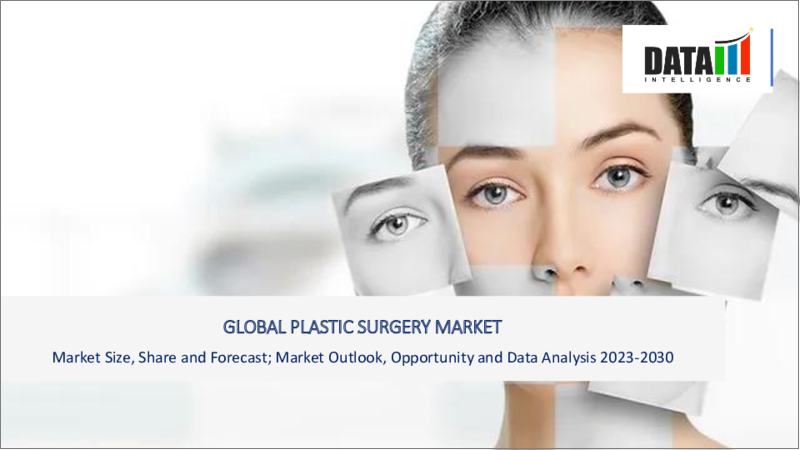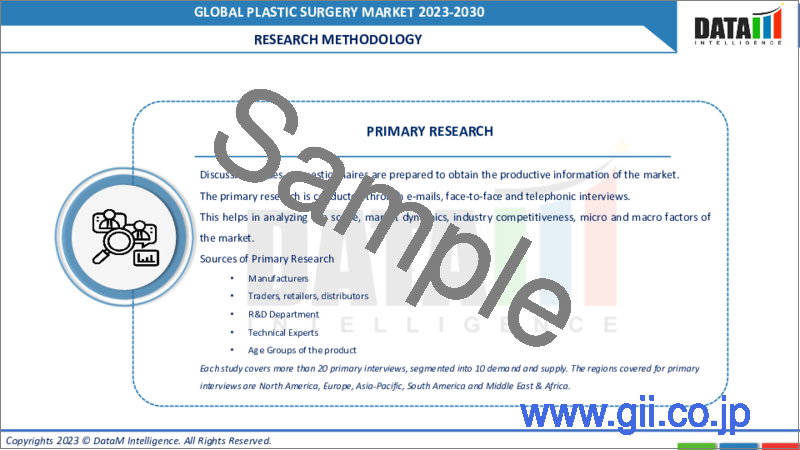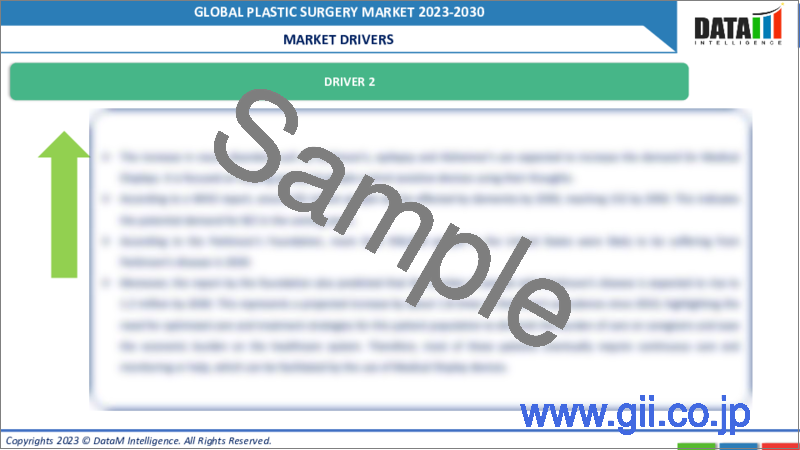|
|
市場調査レポート
商品コード
1290386
形成外科の世界市場-2023-2030Global Plastic Surgery Market - 2023-2030 |
||||||
|
● お客様のご希望に応じて、既存データの加工や未掲載情報(例:国別セグメント)の追加などの対応が可能です。 詳細はお問い合わせください。 |
|||||||
| 形成外科の世界市場-2023-2030 |
|
出版日: 2023年06月12日
発行: DataM Intelligence
ページ情報: 英文 195 Pages
納期: 約2営業日
|
- 全表示
- 概要
- 目次
市場概要
形成外科の世界市場は、2022年に697億米ドルに達し、2030年には最大1,587億米ドルに達することで有利な成長を遂げると予測されています。世界の形成外科市場は、予測期間中(2023年~2030年)に11.1%のCAGRを示すと予測されています。技術の進歩や、新規製品の臨床試験の増加が、形成外科の需要を促進しています。
今、最もホットな話題は、美容整形や形成外科の施術です。一般に安全とされる侵襲性の低い施術には、フィラー、神経毒、レーザー、エネルギー機器などを使ったものがあります。米国美容整形学会によると、30代の女性が美容整形手術を受ける頻度が高く、脂肪吸引の患者の30%は19歳から34歳です。
形成外科の市場範囲は、再建外科手術、美容(審美)外科手術、美容低侵襲手術などの外科手術タイプで構成されており、これが形成外科の市場シェアを高めています。世界の形成外科市場は、研究開発の増加や、各国の主要企業による今後の新規製品承認などの要因によって発展しています。
市場力学
新規製品発売の増加が形成外科市場の成長を促進する
先天性の障害や怪我などの機能不全や不整合は、形成外科によって対処されます。魅力を向上させるために、美容整形が行われます。米国美容外科学会によると、形成外科は見た目を改善したり、正常に機能していない身体部分を治療するために使用されます。
例えば、重度の火傷や先天性の障害を修復するため、あるいは乳房切除後の乳房を再生するために、形成外科手術を受けることがあります。美容整形は、医学的な理由で見た目を改善するのではなく、美的な観点に重点を置いています。人々は、顔や体の見た目を変えるために、フェイスリフトや鼻の手術などの美容整形を受けることがあります。
2023年4月26日、ガルデルマは、ポリL乳酸(PLLA-SCA)の注射剤であるSculptraが、頬の周りの小じわだけでなく、しわに対処するためのFDA承認を与えられたことを明らかにしました。Sculptraは、副次的な目標であった笑顔時の頬のしわに最長2年間対応することに成功し、主な有効性評価項目である安静時の頬のしわが1段階減少することが示されました。したがって、新規製品の発売が増加していることが、形成外科市場を牽引しています。
臨床試験と研究開発の活発化により、メーカーに有利なビジネスチャンスが生まれる
多くの研究者や研究員による臨床研究や基礎科学研究への貢献は、新規治療法の開発を加速させ、病気の起源や経過に関する理解を著しく向上させています。いくつかの臨床試験が実施され、良好な結果が得られています。
パリで開催された世界会議「エイジング・サイエンス2023」マスターコースにおいて、画期的な製品を提供することにコミットした顧客中心の戦略を持つパフォーマンスビューティー企業、エボルス社は、同社の主力神経毒製品であるジュボー(プラボツリナムトキシンAxvfs)をより長期間にわたって「超強力」に作成することを評価した第II相臨床試験の中間データを発表しました。その結果、ジュボーの40U(ユニット)の「エクストラストレングス」製剤は、6カ月または26週間の持続時間プロファイルを実現しました。したがって、これらの要因が形成外科の市場規模の成長を促進することになります。
これらの手術に関連する高いリスクと合併症が、市場の成長を妨げる
血腫は、血のついたポケットのような、大きめの不快なあざです。この結果は、豊胸手術の1~6%で起こります。また、フェイスリフトの副作用として起こることもあります。また、予期せず、血腫から血液を取り除くために追加の手術が必要になることもあります。この問題は、手術中にほぼ必ず発生します。
さらに、術後に最も頻繁に起こる結果のひとつが感染症です。乳房手術後の蜂窩織炎は、患者さんの2~4%がかかる可能性のある合併症です。感染症の中には、より深刻なものもあり、抗生物質の静脈内投与が必要なものもあります。したがって、上記のような要因が形成外科市場の成長を制限しているのです。
COVID-19の影響分析
COVID-19のパンデミックと世界各国でのロックダウンにより、あらゆる業界の企業の財務の健全性が影響を受けています。そのため、COVID-19公衆衛生緊急事態の期間中、米国食品医薬品局(FDA)は、スポンサーや研究者を支援し、試験参加者の安全を確保し、優良臨床試験(GCP)を遵守し、試験の完全性に対するリスクを最小限に抑えるための一般的な配慮を含むガイドラインを発表しました。
ロシア・ウクライナ紛争影響分析
ロシア・ウクライナ紛争は、この地域の主要な市場プレイヤーの数が少ないため、世界の形成外科市場に与える影響は低いと推定されます。
目次
第1章 調査手法とスコープ
- 調査手法
- 調査目的および調査範囲
第2章 定義と概要
第3章 エグゼクティブサマリー
第4章 市場力学
- 影響要因
- 促進要因
- 新規製品上市の増加
- 臨床試験と研究開発の増加
- 抑制要因
- これらの手術に関連する高いリスクと合併症
- 機会
- メディア、ソーシャルメディア、ファッション業界の影響力の高まり
- 影響分析
- 促進要因
第5章 産業分析
- ポーターの5フォース分析
- サプライチェーン分析
- 価格分析
- 法規制の分析
第6章 COVID-19の分析
第7章 外科手術タイプ別
- 再建外科手術
- 腫瘍摘出手術
- 裂傷修復術
- 顎顔面外科手術
- 傷跡の修正
- 手の外科手術
- その他
- 美容(審美)外科手術
- バストアップ
- 鼻の整形
- 脂肪吸引
- フェイスリフト
- まぶたの手術
- ボディコントゥアリング
- 肌の若返り
- その他
- 美容低侵襲手術
- A型ボツリヌス毒素
- 軟組織フィラー
- レーザースキンリサーフェシング
- ケミカルピーリング
- インテンスパルス光治療
- レーザー皮膚除去
- その他
第8章 性別
- 女性
- 男性
第9章 年齢層別
- 年齢層(13~19歳)
- 年齢層(20~29歳)
- 年齢層(30~39歳)
- 年齢層(40~54歳)
- 年齢層(55~69歳)
- 年齢層(70歳以上)
第10章 エンドユーザー別
- 病院
- 手術センター/クリニック
- その他
第11章 地域別
- 北米
- 米国
- カナダ
- メキシコ
- 欧州
- ドイツ
- 英国
- フランス
- スペイン
- イタリア
- その他欧州
- 南米
- ブラジル
- アルゼンチン
- その他南米地域
- アジア太平洋地域
- 中国
- インド
- 日本
- その他アジア太平洋地域
- 中東・アフリカ地域
- 地域別の主なダイナミクス
第12章 競合情勢
- 競合シナリオ
- 市況ポジショニング/シェア分析
- M&A(合併・買収)分析
第13章 企業プロファイル
- Allergan Aesthetics(AbbVie Inc.)
- 会社概要
- 製品ポートフォリオと説明
- 財務概要
- 主な発展状況
- Alma Lasers
- Cynosure LLC
- Galderma
- Bausch Health Companies Inc.
- Merz Aesthetics
- Candela Corporation
- Evolus, Inc.
- Lumenis Be Ltd.
- GC Aesthetics
第14章 付録
Market Overview
The Global Plastic Surgery Market reached US$ 69.7 billion in 2022 and is projected to witness lucrative growth by reaching up to US$ 158.7 billion by 2030. The global plastic surgery market is expected to exhibit a CAGR of 11.1% during the forecast period (2023-2030). The increasing technological advancements and the growing clinical trials for novel products are driving demand for plastic surgery.
The hottest topics in town right now are cosmetic or plastic procedures. The least invasive procedures that are generally deemed safe include those involving fillers, neurotoxins, lasers, and energy devices. According to the American Society for Aesthetic Plastic Surgery, women in their 30s are having cosmetic operations performed more frequently, and 30% of liposuction patients are between the ages of 19 and 34.
The plastic surgery market scope comprises surgical procedure types such as reconstructive surgical procedures, cosmetic (aesthetic) surgical procedures, and cosmetic minimally-invasive procedures, which has increased the plastic surgery market share. The global market for plastic surgery is expanding as a result of factors including increasing research and development and the upcoming novel product approvals by various key players across countries.
Market Dynamics
The Rising Novel Product Launches Drive the Growth of the Plastic Surgery Market
Instances of dysfunction or inconsistency, such as congenital impairments or injuries, are addressed by plastic surgery. In order to improve the attractiveness, cosmetic surgery is used. According to the American Academy of Cosmetic Surgery, plastic surgery is used to improve the look or treat bodily parts that are not working properly.
One might choose to have plastic surgery, for instance, to assist repair serious burns, or congenital impairments, or to rebuild the breast following a mastectomy. Instead of improving the look for medicinal reasons, cosmetic surgery focuses on aesthetic considerations. People may undergo cosmetic surgery, such as a facelift or nose surgery, to alter the appearance of their face or body.
On April 26, 2023, Galderma disclosed that Sculptra, an injectable version of poly-L-lactic acid (PLLA-SCA), was given FDA approval to address wrinkles as well as fine lines around the cheeks. Sculptra successfully addressed cheek wrinkles during smiling for up to two years, which was its secondary goal, and its main efficacy endpoint of a 1-grade reduction in cheek wrinkles at rest. Hence, the growing number of novel product launches is driving the plastic surgery market.
Rising Clinical Trials and Research and Development Create Lucrative Opportunities for Manufacturers
Contributions to clinical research and fundamental science research from a number of researchers or fellows have accelerated the development of novel treatments and significantly improved our understanding of the origins and course of the disease. Several clinical trials are being conducted resulting in positive outcomes.
At the World Congress International Master Course on Aging Science 2023 in Paris, Evolus, Inc., a performance beauty company with a customer-centric strategy committed to delivering ground-breaking products, presented interim data from its Phase II clinical study evaluating an "extra-strength" creation for a longer duration of Jeuveau (prabotulinumtoxinA-xvfs), its flagship neurotoxin product. According to the results, Jeuveau's "extra-strength" formulation at 40U (units) produced a duration profile of six months or twenty-six weeks. Thus, these factors will drive the growth of the plastic surgery market size.
High Risks and Complications Associated with These Surgeries will Hamper the Growth of the Market.
Hematoma is a sizable, uncomfortable bruise that resembles a bloody pocket. This outcome happens in 1 to 6% of breast augmentation surgeries; it can also happen as a side effect of a facelift. Unexpectedly, you might also require additional surgery to remove the blood from a hematoma. This problem occurs almost always during operations.
Furthermore, one of the most frequent postoperative consequences is infection. Cellulitis following breast surgery is a potential complication that may affect 2 to 4 percent of patients. Some infections could be more serious than others and call for intravenous antibiotics. Hence, the above mentioned factors are limiting the plastic surgery market's growth.
COVID-19 Impact Analysis
The financial health of companies across all industries has been impacted by the COVID-19 pandemic and lockdown in numerous nations throughout the world. Therefore, during the period of the COVID-19 public health emergency, the U.S. Food and Drug Administration (FDA) issued guidelines that include general considerations to aid sponsors and researchers, ensuring the safety of trial participants, adhering to good clinical practice (GCP), and minimizing risks to trial integrity.
Russia-Ukraine War Impact Analysis
The Russia-Ukraine conflict is estimated to have a low impact on the global plastic surgery market, owing to the low number of key market players in this region. However, the impact of the import and export of raw materials is expected to have little influence over the global plastic surgery market growth over the forecast period.
Segment Analysis
The global plastic surgery market is segmented based on surgical procedure type, gender, age group, end user and region.
Age Group (30-39) Segment Accounts for 38.1% of the Market Share Owing to the Rising Adoption of Plastic Surgery by This Age Group
Historically, everyone between the ages of 18 and 70 was considered a good candidate for plastic surgery. This is due to the fact that most cosmetic operations perform at their peak once the body has reached its full adult size. Males typically attain adult size between ages 15 and 18, whilst girls typically do so between ages 14 and 18.
Up to 1 million Botox treatments are performed annually on people in this age group, making them the most popular cosmetic procedure. Liposuction or breast augmentation comes next. The "Mommy Makeover" is often chosen by women who are finished having children. This entails a thorough range of procedures designed to get the body back to how it was before getting pregnant. They consist of liposuction, breast lift procedures, and stomach tucks.
The 30-45 age group has the highest rate of cosmetic enhancement procedures performed (42.9% annually), making them the highest likely demographic. Anti-aging and body reshaping operations are among the most common for this age range.
Geographical Analysis
North America Accounted for Approximately 43.9% of the Market Share Owing to the Strong Presence of Major Players and Increasing Technological Advancements
Manufacturers have chances to expand their operations in this region because of the rising demand for plastic surgery for advancements in North America. The area has many producers and suppliers, and its rapid economic development has increased the industrial production of plastic surgery, which has increased the demand.
There are many manufacturers and suppliers in North America, and as a result of the region's rapid economic growth, industrial production has expanded, feeding the desire for cosmetic surgery.
The market will grow as new items or technology for surgeries emerge. Rising technological developments, governmental approvals, and the introduction of new products all contribute to growth. Researchers are becoming more aware of their physical appearance, looks, body shape and many more factors related to their appearance, leading to the expansion of the market in this region. These factors show the dominance of North America.
Competitive Landscape
The major global players in the plastic surgery market include: Allergan Aesthetics (AbbVie Inc.), Cynosure LLC, Alma Lasers, Galderma, Merz Aesthetics, Lumenis Be Ltd., Candela Corporation, Bausch Health Companies Inc., Evolus, Inc. and GC Aesthetics among others.
Why Purchase the Report?
- To visualize the global plastic surgery market segmentation based on surgical procedure type, gender, age group, end user and region, as well as understand key commercial assets and players.
- Identify commercial opportunities by analyzing trends and co-development.
- Excel data sheet with numerous data points of plastic surgery market-level with all segments.
- PDF report consists of a comprehensive analysis after exhaustive qualitative interviews and an in-depth study.
- Product mapping available as Excel consisting of key products of all the major players.
The global plastic surgery market report would provide approximately 53 tables, 54 figures and 195 Pages.
Target Audience 2023
- Manufacturers/ Buyers
- Industry Investors/Investment Bankers
- Research Professionals
- Emerging Companies
Table of Contents
1. Methodology and Scope
- 1.1. Research Methodology
- 1.2. Research Objective and Scope of the Report
2. Definition and Overview
3. Executive Summary
- 3.1. Snippet by Surgical Procedure Type
- 3.2. Snippet by Gender
- 3.3. Snippet by Age Group
- 3.4. Snippet by End User
- 3.5. Snippet by Region
4. Dynamics
- 4.1. Impacting Factors
- 4.1.1. Drivers
- 4.1.1.1. The Rising Novel Product Launches
- 4.1.1.2. Rising Clinical Trials and Research and Development
- 4.1.2. Restraints
- 4.1.2.1. High Risk and Complications Associated with these Surgeries
- 4.1.3. Opportunity
- 4.1.3.1. Rising Influence of Media, Social Media and the Fashion Industry
- 4.1.4. Impact Analysis
- 4.1.1. Drivers
5. Industry Analysis
- 5.1. Porter's 5 Forces Analysis
- 5.2. Supply Chain Analysis
- 5.3. Pricing Analysis
- 5.4. Regulatory Analysis
6. COVID-19 Analysis
- 6.1. Analysis of COVID-19
- 6.1.1. Scenario Before COVID-19
- 6.1.2. Scenario During COVID-19
- 6.1.3. Scenario Post COVID-19
- 6.2. Pricing Dynamics Amid COVID-19
- 6.3. Demand-Supply Spectrum
- 6.4. Government Initiatives Related to the Market During Pandemic
- 6.5. Manufacturers Strategic Initiatives
- 6.6. Conclusion
7. By Surgical Procedure Type
- 7.1. Introduction
- 7.1.1. Market Size Analysis and Y-o-Y Growth Analysis (%), By Surgical Procedure Type
- 7.1.2. Market Attractiveness Index, By Surgical Procedure Type
- 7.2. Reconstructive Surgical Procedure *
- 7.2.1. Introduction
- 7.2.2. Market Size Analysis and Y-o-Y Growth Analysis (%)
- 7.2.3. Tumor Removal Surgery
- 7.2.4. Laceration Repair
- 7.2.5. Maxillofacial Surgery
- 7.2.6. Scar Revision
- 7.2.7. Hand Surgery
- 7.2.8. Others
- 7.3. Cosmetic (aesthetic) Surgical Procedure
- 7.3.1. Breast Enhancement
- 7.3.2. Nose Reshaping
- 7.3.3. Liposuction
- 7.3.4. Face Lift
- 7.3.5. Eye-lid Surgery
- 7.3.6. Body Contouring
- 7.3.7. Skin Rejuvenation
- 7.3.8. Others
- 7.4. Cosmetic Minimally-Invasive Procedures
- 7.4.1. Botulinum Toxin Type A
- 7.4.2. Soft Tissue Filler
- 7.4.3. Laser Skin Resurfacing
- 7.4.4. Chemical Peel
- 7.4.5. Intense Pulsed Light Treatment
- 7.4.6. Laser Skin Removal
- 7.4.7. Others
8. By Gender
- 8.1. Introduction
- 8.1.1. Market Size Analysis and Y-o-Y Growth Analysis (%), By Gender
- 8.1.2. Market Attractiveness Index, By Gender
- 8.2. Female *
- 8.2.1. Introduction
- 8.2.2. Market Size Analysis and Y-o-Y Growth Analysis (%)
- 8.3. Male
9. By Age Group
- 9.1. Introduction
- 9.1.1. Market Size Analysis and Y-o-Y Growth Analysis (%), By Age Group
- 9.1.2. Market Attractiveness Index, By Age Group
- 9.2. Age Group (13-19) *
- 9.2.1. Introduction
- 9.2.2. Market Size Analysis and Y-o-Y Growth Analysis (%)
- 9.3. Age Group (20-29)
- 9.4. Age Group (30-39)
- 9.5. Age Group (40-54)
- 9.6. Age Group (55-69)
- 9.7. Age Group (70+)
10. By End User
- 10.1. Introduction
- 10.1.1. Market Size Analysis and Y-o-Y Growth Analysis (%), By End User
- 10.1.2. Market Attractiveness Index, By End User
- 10.2. Hospitals *
- 10.2.1. Introduction
- 10.2.2. Market Size Analysis and Y-o-Y Growth Analysis (%)
- 10.3. Surgical Centers/ Clinics
- 10.4. Others
11. By Region
- 11.1. Introduction
- 11.1.1. Market Size Analysis and Y-o-Y Growth Analysis (%), By Region
- 11.1.2. Market Attractiveness Index, By Region
- 11.2. North America
- 11.2.1. Introduction
- 11.2.2. Key Region-Specific Dynamics
- 11.2.3. Market Size Analysis and Y-o-Y Growth Analysis (%), By Surgical Procedure Type
- 11.2.4. Market Size Analysis and Y-o-Y Growth Analysis (%), By Gender
- 11.2.5. Market Size Analysis and Y-o-Y Growth Analysis (%), By Age Group
- 11.2.6. Market Size Analysis and Y-o-Y Growth Analysis (%), By End User
- 11.2.7. Market Size Analysis and Y-o-Y Growth Analysis (%), By Country
- 11.2.7.1. The U.S.
- 11.2.7.2. Canada
- 11.2.7.3. Mexico
- 11.3. Europe
- 11.3.1. Introduction
- 11.3.2. Key Region-Specific Dynamics
- 11.3.3. Market Size Analysis and Y-o-Y Growth Analysis (%), By Surgical Procedure Type
- 11.3.4. Market Size Analysis and Y-o-Y Growth Analysis (%), By Gender
- 11.3.5. Market Size Analysis and Y-o-Y Growth Analysis (%), By Age Group
- 11.3.6. Market Size Analysis and Y-o-Y Growth Analysis (%), By End User
- 11.3.7. Market Size Analysis and Y-o-Y Growth Analysis (%), By Country
- 11.3.7.1. Germany
- 11.3.7.2. The U.K.
- 11.3.7.3. France
- 11.3.7.4. Spain
- 11.3.7.5. Italy
- 11.3.7.6. Rest of Europe
- 11.4. South America
- 11.4.1. Introduction
- 11.4.2. Key Region-Specific Dynamics
- 11.4.3. Market Size Analysis and Y-o-Y Growth Analysis (%), By Surgical Procedure Type
- 11.4.4. Market Size Analysis and Y-o-Y Growth Analysis (%), By Gender
- 11.4.5. Market Size Analysis and Y-o-Y Growth Analysis (%), By Age Group
- 11.4.6. Market Size Analysis and Y-o-Y Growth Analysis (%), By End User
- 11.4.7. Market Size Analysis and Y-o-Y Growth Analysis (%), By Country
- 11.4.7.1. Brazil
- 11.4.7.2. Argentina
- 11.4.7.3. Rest of South America
- 11.5. Asia-Pacific
- 11.5.1. Introduction
- 11.5.2. Key Region-Specific Dynamics
- 11.5.3. Market Size Analysis and Y-o-Y Growth Analysis (%), By Surgical Procedure Type
- 11.5.4. Market Size Analysis and Y-o-Y Growth Analysis (%), By Gender
- 11.5.5. Market Size Analysis and Y-o-Y Growth Analysis (%), By Age Group
- 11.5.6. Market Size Analysis and Y-o-Y Growth Analysis (%), By End User
- 11.5.7. Market Size Analysis and Y-o-Y Growth Analysis (%), By Country
- 11.5.7.1. China
- 11.5.7.2. India
- 11.5.7.3. Japan
Australia
- 11.5.7.4. Rest of Asia-Pacific
- 11.6. Middle East and Africa
- 11.6.1. Introduction
- 11.6.2. Key Region-Specific Dynamics
- 11.6.3. Market Size Analysis and Y-o-Y Growth Analysis (%), By Surgical Procedure Type
- 11.6.4. Market Size Analysis and Y-o-Y Growth Analysis (%), By Gender
- 11.6.5. Market Size Analysis and Y-o-Y Growth Analysis (%), By Age Group
- 11.6.6. Market Size Analysis and Y-o-Y Growth Analysis (%), By End User
12. Competitive Landscape
- 12.1. Competitive Scenario
- 12.2. Market Positioning/Share Analysis
- 12.3. Mergers and Acquisitions Analysis
13. Company Profiles
- 13.1. Allergan Aesthetics (AbbVie Inc.) *
- 13.1.1. Company Overview
- 13.1.2. Product Portfolio and Description
- 13.1.3. Financial Overview
- 13.1.4. Key Developments
- 13.2. Alma Lasers
- 13.3. Cynosure LLC
- 13.4. Galderma
- 13.5. Bausch Health Companies Inc.
- 13.6. Merz Aesthetics
- 13.7. Candela Corporation
- 13.8. Evolus, Inc.
- 13.9. Lumenis Be Ltd.
- 13.10. GC Aesthetics
LIST NOT EXHAUSTIVE
14. Appendix
- 14.1. About Us and Services
- 14.2. Contact Us




